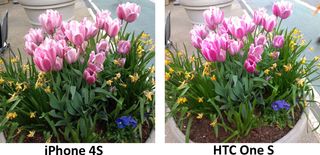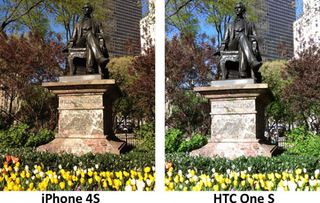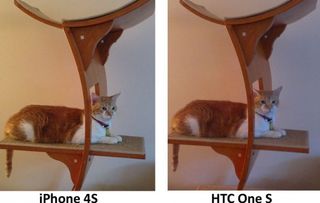Smartphone Camera Shootout: HTC One S vs. iPhone 4S

Though most current Android smartphones come with high-resolution cameras, most of these pale in comparison to the iPhone 4S' 8-MP shooter Not only does the average Android camera take lower quality pictures than Apple's handset, it also takes a lot longer to fire up and shoot. HTC's new One S phone promises to change all that by providing high-speed shots, an f/2.0 aperture 8-MP lens for improved picture quality, and powerful camera software that provides over a dozen filters, HDR mode and more.
To see which phone takes the best pictures and provides the best overall photo-taking experience, we grabbed an HTC One S and an iPhone 4S and used them to shoot the same subjects. The results may surprise you.
Detail Shots

When we shot a photo of a stone relief on our office roof with both phones on auto mode, the iPhone 4S's photo appeared just a bit sharper and more detailed. Considering that the stone was covered with late-afternoon shadows, the iPhone also captured more light, resulting in a brighter image.
Winner: iPhone
HDR Pictures
Both phones support high dynamic range (HDR) photography. HDR photos provide a greater degree of contrast between foreground and background objects by effectively light-metering them differently. So, with HDR enabled, a building should look just as bright and colorful as the blue sky behind it.
Stay in the know with Laptop Mag
Get our in-depth reviews, helpful tips, great deals, and the biggest news stories delivered to your inbox.
Unfortunately, after you shoot an HDR photo, you have to wait a good 3 to 4 seconds for it to process. So you'll only want to use HDR mode for high-contrast situations where a foreground object is significantly lighter or darker than the scene behind it.

To test HDR on both phones, we went up on our roof and shot a picture of some buildings against a blue sky. Though both shots look great, the iPhone 4S's photo seems just a bit more colorful, particularly when you look at the blue in the sky, the white in the tower and the green in the dome.

This photo of a church was also taken in HDR and, as you can see, both the sky and the stone walls of the church appear much brighter and more colorful in the iPhone's photo.
Winner: iPhone 4S
Outdoor Shots

When we took a photo of a tree, we noticed that the iPhone 4S's version was sharper and a little bolder in terms of saturation.

When we shot a bed of flowers in a shady area, the HTC One S's picture was brighter, but the iPhone 4S's shot seemed a bit more accurate, given the shady lighting. Which you prefer --the more true-to-life shot or the more vibrant shot -- is a matter of personal preference.

In this photo of a statue, colors are clearly richer on the iPhone 4S, while they seem a bit washed out on the HTC One S. And while the statue appears brighter in the One S shot, the details get blown out a bit.
Indoor Shots
To test out each phone's ability to shoot indoors, we brought them home to our apartment and took some photos of a baby and a cat.

In real life, the room was rather dim, but the iPhone 4S brightened up the photo a bit. The cat's fur seems much sharper in the iPhone 4S's picture than in the HTC One S's. We notice, however, that the iPhone's pictures have a bit of a yellow hue while the One S's seem more red and purple.

When we shot a baby who was a bit red in the face, the photo on the HTC One S seemed sharper and more accurately reflected his real-world skin tone. However, the sunnier colors on the iPhone 4S looked pretty attractive.

We also shot a photo of some random objects and found that colors like the red in an Iron Man bobble head doll were just a little deeper in the iPhone 4S's picture.
Winner: iPhone 4S by a narrow margin
Shutter Speed
HTC claims that the One S can shoot a photo in just .7 seconds, and when we timed the shutter with a stopwatch, it took around that amount of time. When we performed the same test on the iPhone 4S, times were also under a second so it seems like both of these phones are equally speedy. Neither phone has a dedicated camera button, but both let you launch their camera apps directly from their lock screens, making it easy to start a photo session in just a second or two.
Though the phones shoot single photos with equal speed, only the HTC One S is able to shoot in a .2-second burst mode that lets you quickly capture action shots. When you hold down the shutter button, the One S shoots up to 99 pictures in a row and then allows you to designate one as the "best shot" and discard the others.
Winner: HTC One S
1080p Video
Unlike most phones, both the iPhone 4S and the HTC One S can shoot 1080p video. We shot a few seconds of HD footage of cars rolling down Fifth avenue on a cloudy day. Though both videos are sharp, smooth and colorful, the One S's video looked just a touch more vibrant. The One S also supports 60 fps slow-motion video, something you can't do on the iPhone 4S at all.
Winner: HTC One S
Special Effects and Filters
When it comes to camera software, the HTC One S beats the iPhone 4S hands down. Where the iPhone's preloaded camera software gives users minmal options, HTC's ImageSense software provides a bevy of special effects and features.
Using the One S's camera app, we were able to shoot panoramic images, tweak the light mode, and apply more than a dozen filters to our photos before we shot them. We particularly like the dots filter which makes photos look like a cubist painting, but users can also take advantage of a couple of "vintage" filters which make your photos look like they belong on Instagram. If you decide you want to turn your photo into sepia colors or use the distort effect on it after you've already shot it, you can apply any of the filters by tapping Edit in the Gallery.

Because of the speed of the camera, users can also take a series of 99 action shots at once and then choose the "best photo" with the software. The app even lets you shoot still pictures while filming a video.
With the iPhone 4S, you do get some basic editing features that let you crop, remove red eye from and otherwise enhance pictures after they've already been shot. While the One S does not come with a dedicated red-eye removal tool in its editor, it allows you to crop photos, apply effects and even adjust the brightness, contrast and color levels on photos. In iOS, you need third-party apps like Camera Plus to apply effects to your photos.

Winner: HTC One S
Verdict
Both the iPhone 4S and the HTC One S have really strong 8-MP cameras that are capable of shooting sharp, colorful still images in under a second. Both phones can also capture great 1080p video, and provide support for HDR.
When it comes to features, the HTC One S is superior to the iPhone in every way, offering burst mode, the ability to shoot photos while filming video, slow motion video capture, and a wide variety of filters and settings you can't get on the iPhone without third party software. Because of all these functions, the act of shooting pictures on the HTC One S is a lot more fun than on the iPhone 4S.
However, there's a noticeable difference in still image quality that favors the iPhone. Though both take attractive photos, the iPhone's pictures are almost always brighter, sharper and more colorful than the One S's. When you look closely at pictures from the two phones side-by-side, it's clear that -- at least in the automatic and HDR modes we used -- the iPhone's photos feel warmer and have more of a yellow hue while the HTC One S's shots are colder and have more of dark red or purple bias. In almost all cases, the iPhone photos were sharper and more detailed so when you combine that with warmer colors, you have better looking images.
If you're looking for the smartphone with the best software, the HTC One S for T-Mobile is your best choice. If you're looking for the best Android phone camera experience, the HTC One S is probably your best choice too. However, if still image quality is your top concern, the iPhone 4S is simply the better handset. Given the choice, we'll always prioritize image quality over camera features so we have to give this face-off to the iPhone 4S.
OVERALL WINNER: iPhone 4S
